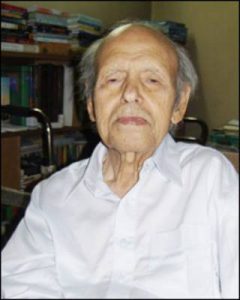This essay was translated exclusively for MULOSIGE by Munir Fayyaz. It is published here as part of MULOSIGE’s Urdu Translated Essays project.
Wazir Agha. Source: Wikimedia Commons
Maghribī tanqīd ke sau sāl aur imtizāji tanqīd
from tanqīdī theory ke sau sāl (One Hundred Years of Critical Theory)
by Wazir Agha (1922-2010)
Translated into English by Munir Fayyaz
To find the original essay in Urdu, please turn to pages 179-185 here.
_______
 It was not very long ago that Urdu criticism started discussions on the newest ideologies of western criticism and then immediately harmonized itself with them. When there is such a quick progression in any genre of literature, its reaction is also very severe; therefore, the orthodox cult, especially the people attached with some stagnant literary ideology, rejected this new progression in Urdu literary criticism…. This was a good thing as the reaction helped the action flourish and nourish in a better way. The factors mentioned above persisted so much that now structuralist criticism is still highly promoted by some Urdu critics even as it has died down in the west but is resurrected in Urdu! I modestly state that nothing dies in literature. The study of literature is not akin to archaeology; it resembles geology. Literary genres, ideologies and fashions do not exist layering upon one another (as some cities establish on the ruins of some older cities), the whole past breaths in the present, living moment. Northrop Frye has tellingly commented on people proclaiming the demise of some literary genres and ideologies: he writes that such people are not really critics; they are commentators and chatters (sitting in a tea house) who consider the fame of poets analogous to an imaginary stock exchange. Frye’s words are as follows:
It was not very long ago that Urdu criticism started discussions on the newest ideologies of western criticism and then immediately harmonized itself with them. When there is such a quick progression in any genre of literature, its reaction is also very severe; therefore, the orthodox cult, especially the people attached with some stagnant literary ideology, rejected this new progression in Urdu literary criticism…. This was a good thing as the reaction helped the action flourish and nourish in a better way. The factors mentioned above persisted so much that now structuralist criticism is still highly promoted by some Urdu critics even as it has died down in the west but is resurrected in Urdu! I modestly state that nothing dies in literature. The study of literature is not akin to archaeology; it resembles geology. Literary genres, ideologies and fashions do not exist layering upon one another (as some cities establish on the ruins of some older cities), the whole past breaths in the present, living moment. Northrop Frye has tellingly commented on people proclaiming the demise of some literary genres and ideologies: he writes that such people are not really critics; they are commentators and chatters (sitting in a tea house) who consider the fame of poets analogous to an imaginary stock exchange. Frye’s words are as follows:
“The literary chit-chat, which makes the reputation of poets boom and crash in an imaginary Stock Exchange, is pseudo-criticism.”
The fact is that Urdu criticism has not only consumed its time with the analysis of Structuralism; it has also contemplated preceding literary frameworks including Historical and Biographical Criticism, Russian Formalism and New Criticism (with reference to Richards, Lewis, Empson, Eliot and others) since it is impossible to understand Structuralist Criticism without understanding these predecessors. Urdu criticism has also shown how structuralist debates blended with Marxist Criticism (with reference to Althusser, Julia Kristeva, etc.) and Psychological Criticism (with reference to Lacan). Moreover, it also explored Phenomenological Criticism (with reference to the Geneva School), Deconstructive Criticism (with reference to Derrida, Paul de Man and others), Feminist Criticism, Neo-Historical Criticism and Readers Response Criticism (whose parallel in Germany is Reception Theory). Around the clock, there are here regarding critical theory in the West and not a day goes by when a new angle or perspective is not highlighted. This does not mean that the new ideas cancel all the previous ideas as literary criticism, like literature, presents a scenario of synthesis and coordination, not of rejection and negation. If we see look at it from this perspective, Western Criticism of the last century appears as an ‘organic whole’ which considers the interpretation and explanation of literature, its pragmatics, and its many innovations and devices all together in order to know the infrastructure of literature closely. Different schools of western criticism have tried to access ‘the text’ with their respective tools; they influenced one another and conflicted with one another as well: this harmony and clash resulted in the birth of some newer ideologies while some ideologies went into the background. Nonetheless, we can see Western Criticism clearly as an organic whole.
The story of twentieth-century western criticism is very long. Perhaps a common reader will gain some insight about it if we try to explain it with the help of an analogy, although this will give only give us a vague sketch:
Imagine that text is like a motorcar!
Historicism and biographic criticism from the past century would consider who the manufacturer of this car is, where he stands in the historical context, and what historical processes generated this car. The car would get ignored but its maker would come under consideration. Russian Formal Criticism wouldn’t care about the car’s maker; it would only hold the mechanical structure of the car to be significant and would focus on the unique mechanical structure rather than calling the car a mere piece of iron, which is the material we work with when processing the iron into a car; it would stress the need of making the car unique and unfamiliar. On the other hand ‘New Criticism’ would reject the maker of the car as well as its historic context. Instead, it would regard the car as an autonomous, automatic unit, review the functioning of its collective parts, and try to see what meanings spring from those functions. Structural Criticism would focus on the deep structure hidden within the car like a poetic system of codes and rules, ignoring its more visibly apparent structure. It would then to see how the performance of the car takes place according to this deeper system. Structuralism would pay special heed to the driver of the car—the reader—and would credit the creative impulse under which he reads the text for the presence and performance of the car. Deconstructive Criticism would make a noise at this and would say that Structuralism has tried to sell an old wine in a new bottle, arguing that it has, in fact, affirmed the presence of the creator of the text by substituting him with the system. Moreover, it would argue that Structuralism claims to dismount the maker of the car but, on the contrary, it has only changed his look and has kept him concealed somewhere inside the car. Deconstructive Criticism would focus its attention on the scenario created by the speed of the car and would say: Do not focus on who made this car or how its machinery functions or according to what internal system it is running on; focus, instead, on how the surrounding scenes change by the movement of this car and how new scenes are reflecting in that scenario and how further new scenarios in those new scenes are made. Not a single scene, not a single meaning is fixed or everlasting; your eyes are not able to focus on a single scene (or meaning); they are disentangling the layers of the forest of meanings underlying in it. Can’t you see how each scene is spatially different from the others and procrastinating its meanings in time?…..free yourself from the captivations of closed and fixed meanings and look at the abyss of the scenario appearing through the windows of the car, not for the sake of getting any meanings but for the everlasting, never ending entourage of the seeing eye, which is its own greatest reward. On hearing this talk of deconstruction, Eco would smile and ask ‘why have you brought the explanatory style to such a conceited, very-interpretation level?’ Jonathan Culler would reply that this is the real thing and by doing so one can get into the many layers of a scenario. On the mention of multi-layered scenarios, the Marxist critic would become outraged and rejecting him loudly, would hang red curtains on the windows of the car to avoid being distracted by these ever changing vistas and to remain focused on that distant goal (a fixed meaning or static, photographic scene) which he aspires to reach. But the flag bearers of New Historicism, Foucault in particular, would reject this approach of the conventional historical critics for whom history takes its continuum under the influence of some fixed, external principle or constant Historical a Priori. He does not agree with this proposition of the Deconstructionists that the whole scenario is merely a maze with no room for the historical process. He would say that you should neither view different scenes from the windows of the car as ‘ideal scenes’ nor see them as becoming part of some scenic maze. You should look at them to note how every scene hold its distinct identity and also appears dynamic in a synchrony with other scenes!
Looked on as a whole, we may say that western criticism of the last century, has worked on the trilogy of ‘the Author, the Text, and the Reader’. At first the Author was given primary importance, then the text and, in the end, the reader. The matter of the importance of the reader is so vital that Reader Response Criticism and Reception Theory have included the performance of the reader as an equally important perspective as all the other critical angles. This is a very significant step towards Synthetic Criticism. Therefore, my take is this that the twenty-first century will be the century of synthesis and merger in which a synthetic style of criticism will be promoted and the trio of ‘author, text and reader’ will be viewed together.
 I should be clear that Synthetic Criticism is itself a product of today’s expanding horizons of culture, society, and knowledge. Its boundaries expand to Philosophy, Linguistics, Psychology, Anthropology, Existentialism, Phenomenology, and Physics. If we think back to our analogy of the car, Synthetic Criticism uses the help of the back view mirror as well as the front screen and windows. It gives a sense of liberty that cannot be achieved through looking through the window or through the peephole of some forced or self imposed ideology. Most of our contemporary critics have informed themselves of different ideologies coming out of the debates of contemporary critical theory, but they have not made any contributions therein. They also have not considered this scenario has been shaped from the dialogues and debates between different schools of criticism. Thirdly, they have not turned to practical criticism after acquiring the quintessential ideological elements of the critical theory (thought this third point comes with some exceptions). Therefore, it is essential that a synthetic angle gets promoted in criticism so that we may approach the text from many sides, simultaneously.
I should be clear that Synthetic Criticism is itself a product of today’s expanding horizons of culture, society, and knowledge. Its boundaries expand to Philosophy, Linguistics, Psychology, Anthropology, Existentialism, Phenomenology, and Physics. If we think back to our analogy of the car, Synthetic Criticism uses the help of the back view mirror as well as the front screen and windows. It gives a sense of liberty that cannot be achieved through looking through the window or through the peephole of some forced or self imposed ideology. Most of our contemporary critics have informed themselves of different ideologies coming out of the debates of contemporary critical theory, but they have not made any contributions therein. They also have not considered this scenario has been shaped from the dialogues and debates between different schools of criticism. Thirdly, they have not turned to practical criticism after acquiring the quintessential ideological elements of the critical theory (thought this third point comes with some exceptions). Therefore, it is essential that a synthetic angle gets promoted in criticism so that we may approach the text from many sides, simultaneously.
John Stroke has written in favor of a ‘free mobility across the intellectual landscape’. This idea comfortably conforms with synthetic criticism. Emerson said:
“In the scene in front on field is of A, the second is of B and the third is of C, but the whole of this landscape is mine.”
It is precisely this sentiment which lies behind Synthetic Criticism .



Leave A Comment